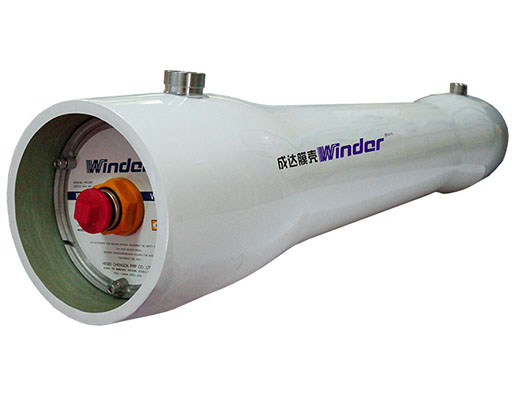When one thinks of reverse osmosis (RO) systems, the image in one's mind is of long, horizontal, usually white pressure vessels. When you can't see the reverse osmosis membrane inside it, its shell can be recognized immediately.
Today, most reverse osmosis membranes are housed in glass fiber reinforced (FRP) pressure vessels, which are specially manufactured to hold the membranes and withstand the high pressures required for today's reverse osmosis membranes. These are not only plastic tubes but pressure vessels that have been rigorously designed and manufactured.
The FRP pressure vessel is made of glass-fiber spools and is kept together through a specific grade of epoxy resin, which hardens at high temperatures. The manufacturing process is controlled by a computer, and each strand is placed in a specific position and direction for optimal strength. A mixture of fiberglass and resin is wound around the precision-machined mandrel, which represents the perfectly rounded, faultless interior of today's reverse osmosis vessels. Blood vessels are usually painted white to reduce light transmission through them, thus minimizing algal growth and other biological problems.

Frp Pressure Vessel
These products are usually designed, manufactured, and tested in accordance with the strict ASME boiler and pressure vessel code, which has a specific part X of an FRP pressure vessel. Each manufacturer is required to identify the container by first performing 100,000 circulating hydrostatic tests from scratch. Design pressure, all work at 150°F (above the operating limit of all current RO films). Subsequent destructive tests subjected the vessel to increasing pressure until a failure occurred.
In order to comply with the ASME code, the vessel must not leak during the cycle test and must successfully meet a safety factor of six times (6X) of the vessel design pressure. In addition, each key material must be identified and production methods documented. Each facility with ASME code badges is subject to ASME review every five years. Every step of ship design, production, and testing is reviewed by the ASME Audit Committee.
The pressure class range of today's reverse osmosis vessels depends on the membrane used and the type of water being treated. Seawater has a high osmotic pressure (~ 400 psi), which means that high operating pressure is required to overcome the osmotic pressure created in the concentrate flow. Other common pressure classes are 300, 450, 600, and 1,000 psi. The newly developed higher pressure classes (up to 1800 psi) are now available.
The next time you see a reverse osmosis system, you know that the design and production of FRP composite pressure vessels containers have gone into a wide range of engineering, and pressure containers have become a trademark of the reverse osmosis industry.